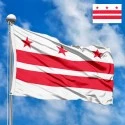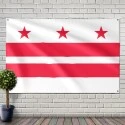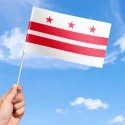Flag of the District of Columbia USA
- Flag Type: Regional
- Proportions (official): 1:2
- Official name: District of Columbia
- Sovereignty (year): NO (Federal district of the USA)
- Population: ~670,000 (2024, estimate)
- Religions: Christianity ~50%
- Area (km²): 177
- Highest point: Tenleytown (125 m)
- Lowest point: Potomac River (0 m)
Flag Information
General information
Demography and Culture
- All Flags
- Flags of Countries by Continent
-
Flags of Organizations
- Flags of UN countries
- Flags of the European Union countries
- Flags of NATO countries
- Flags of the countries of the Organization of Islamic Cooperation
- Flags of the countries of the Organization of American States
- Flags of the Arab League countries
- Flags of the African Union countries
- Flags of the countries of the Union of South American Nations
- Flags of the Commonwealth of Nations
- Flags of the countries of the Secretariat of the Pacific Community
- Flags of the Nordic Council countries
- Flags of the Caribbean Community
- Flags of the countries of the Association of Southeast Asian Nations
- Flags of the East African Community
- Flags of the countries of the Organization of Turkic States
- LGBT Community Flags
- Historical Flags
- Ethnic Flags
- Flags of the USA (states)
Description
The Flag of the District of Columbia is a powerful visual identity for the United States’ capital, a symbol that elegantly combines historical homage with modern civic pride. Unlike many American state flags that feature complex seals or emblems, D.C.'s flag stands out for its striking simplicity and clean, heraldic design. It is more than just a banner for a city; it is a profound representation of the district's unique and often complicated status as the nation's federal seat. The flag’s design tells a story of its namesake, George Washington, and its residents' enduring quest for full representation and local identity. From its late adoption to its modern-day embrace as a symbol of statehood, the flag has become a rallying point for the city's inhabitants, a banner of a community that is fiercely proud of its home and its place in American history.
Design and Dimensions: A Heraldic Legacy in Red and White
The design of the District of Columbia flag is a masterpiece of vexillology—the study of flags—widely celebrated for its simplicity and aesthetic appeal. It is based on a historic coat of arms, a detail that gives it a unique connection to its founder and sets it apart from other American municipal flags.
-
The Field and Colors: The flag consists of a pristine white field, which serves as a stark and powerful backdrop. This white is broken by two distinct horizontal red bars. Above these bars, in the upper white space, are three five-pointed red stars. The colors are a classic combination of red and white, colors that are not only dominant in the U.S. flag but also reflect a timeless and bold aesthetic. The design is deliberately simple, making it instantly recognizable and easy to reproduce, a key characteristic of an effective flag.
-
Proportions and Placement: The official statute governing the flag is specific about its proportions, ensuring visual harmony and consistency. The flag's overall ratio of width to length is 1:2. The two red horizontal bars occupy a significant portion of the flag's vertical space. The top red bar and the bottom red bar are each one-fifth (1/5) of the flag’s hoist (the vertical dimension). Between these two bars is a white space that is also one-fifth (1/5) of the hoist. The three red stars, known in heraldry as mullets, are placed in the white section above the bars. Each star's diameter is exactly two-fifths (2/5) of the width of this top white section. The stars are spaced equidistantly, creating a balanced and elegant arrangement. The strict adherence to these proportions ensures that the flag is always a perfect representation of its intended design, a testament to the thoughtful planning that went into its creation.
-
Meaning of the Elements: While the design is based on George Washington's family coat of arms, the symbolic meaning of the stars and bars has been a subject of interpretation. The most widely accepted understanding is that the flag represents a direct homage to the nation's first president, a fitting tribute to the man for whom the district is named. The three stars have been anecdotally associated with the three co-equal branches of the U.S. government (the executive, legislative, and judicial branches), all of which are located within the District. This interpretation reinforces D.C.'s role as the nation's political center. However, the most profound meaning is found in the flag's historical connection to the Washington family, making it a banner of both national and regional identity.
History and Origins: From a Lack of Identity to a Symbol of Unity
For over a century and a half, the District of Columbia, despite its paramount importance to the United States, lacked an official flag. This void was a reflection of the district's unique political status and its residents' lack of voting representation in Congress. The flag's creation story is one of a long and sometimes contentious journey to find a unique visual identity for a city that was, in many ways, an unrepresented federal territory.
-
The Search for a Flag (Early 20th Century): Before 1938, the city used various unofficial banners, including the flag of the D.C. National Guard. The need for an official symbol grew, and in the early 1920s, a movement for a flag began to gain momentum, championed in part by organizations like the Daughters of the American Revolution. Several designs were proposed, many of them complex and featuring the Great Seal of the United States. These proposals, however, were often seen as too busy and lacking a distinct local character.
-
Charles A. R. Dunn's Vision: The design that would eventually be adopted was created by a graphic designer named Charles A. R. Dunn. In 1924, Dunn submitted his design, which was inspired by the coat of arms of the Washington family, a heraldic design that had been in use in England since the 12th century. The coat of arms, featuring two red horizontal bars and three red stars on a white shield, was an elegant and historically significant choice. Dunn's initial design featured blue stars, but he later revised it with red stars to more closely match the colors of the U.S. flag.
-
Official Adoption (1938): Dunn's design languished for years. It wasn't until 1938 that a special commission, appointed by Congress, was tasked with finally selecting a flag. The commission reviewed many proposals, but ultimately, Dunn's design was chosen. It was officially adopted on October 15, 1938. The fact that the flag was chosen by a federally appointed commission, and not by the residents themselves, was a source of some controversy at the time, highlighting the very issue of "taxation without representation" that D.C. residents still face. Despite this, the flag's simple yet powerful design quickly gained favor.
Interesting Facts and a Modern Symbol of Statehood
The flag of the District of Columbia is more than just an emblem; it's a a canvas for political expression and a source of civic pride. Its history is filled with fascinating anecdotes that underscore its unique role.
-
One of the Best-Designed Flags: The North American Vexillological Association (NAVA) ranked the D.C. flag 8th out of 150 American city flags in a 2004 survey, a testament to its clean lines, bold colors, and memorable design. It is often cited as a prime example of good flag design, contrasting sharply with many state flags that are often criticized for being overly complex.
-
"Taxation Without Representation": The flag has become a powerful tool for the D.C. statehood movement. The popular protest slogan "Taxation Without Representation" is a direct response to the district's lack of voting members in Congress, a situation that many residents find unjust. While the slogan has appeared on a proposed flag design, it is more commonly seen on D.C. license plates. This modern-day use of a revolutionary-era phrase connects the district's struggle for political rights to the very founding of the United States.
-
The Stars and Bars: A Heraldic Blazon: In formal heraldic language, the flag's design is described as "Argent two bars Gules, in chief three mullets of the second." This elegant terminology, which translates to "A white field with two red bars, and three red stars above them," underscores the design's historic and heraldic roots, a nod to the Washington family's heritage.
Significance for the Inhabitants: A Banner of Local Identity and Resilience
For the residents of the District of Columbia, the flag has a significance that goes far beyond its aesthetic appeal. It is a potent symbol of local identity, resilience, and the ongoing struggle for political equality.
The flag represents the community's fierce pride in their city, a place that is not only the nation's capital but also a vibrant, diverse, and unique home. When residents display the flag, they are not just showing patriotism for the United States; they are declaring their love for their city, its neighborhoods, its culture, and its people. This local pride is particularly strong because of the city's distinct status. D.C. is a community that governs itself but does so under the ultimate authority of Congress, a situation that has fostered a strong sense of shared purpose and a collective identity forged in the fight for more autonomy.
Furthermore, the flag has become a crucial emblem for the D.C. statehood movement. The stars and bars, a design rooted in the founding of the country, serve as a constant reminder that the city's inhabitants are Americans who are denied the full rights of citizenship. For activists and residents advocating for statehood, the flag is a visible and universally recognized symbol of their cause. It represents the hope for a future where the District of Columbia is the 51st state, where its residents have a voting voice in Congress, and where the promise of "justice for all," as emblazoned on the district's seal, finally becomes a reality. The flag, therefore, is not merely a historical relic; it is a living symbol of a community’s aspirations and its unyielding spirit.
In the demonstration images, full-size flags are shown with proportions of 2:3, and hand-held flags with proportions of 1:2.
Donation
Download
Completely free for commercial and non-commercial use (public domain).
You can freely use them in your news magazines, websites, software, mobile applications.
We appreciate a backlink to https://flagssite.com
Raster files - Flag of the District of Columbia USA (PNG, JPG)
 Waving flag
Waving flag
- PNG format (transparent background), 72dpi, dimensions in Pixels (px), aspect ratio 3:4.
- 15х20 px
- 30х40 px
- 60х80 px
- 120x160 px
- 240x320 px
 Sizes:
Sizes:
"v15" - image size (by height); if necessary, replace with available: v15, v30, v60, v120, v240.
!!! For resizing, use the Latin (eng) keyboard layout.
<img src="https://flagssite.com/flags/v15/20542.png" alt="Flag of the District of Columbia USA">
 Round flag
Round flag
- PNG format (transparent background), 72dpi, dimensions in Pixels (px), aspect ratio 1:1.
"d15" - image size (diameter); if necessary, replace with available: d15, d30, d60, d120, d240.
!!! For resizing, use the Latin (eng) keyboard layout.
<img src="https://flagssite.com/flags/d15/20542.png" alt="Flag of the District of Columbia USA">
 Rectangular flag 2:3
Rectangular flag 2:3
- JPG format, 72dpi, dimensions in Pixels (px), aspect ratio 2:3.
"h30" - image size (by height); if necessary, replace with available: h15, h30, h60, h120, h240, h360, h480.
!!! For resizing, use the Latin (eng) keyboard layout.
<img src="https://flagssite.com/flags/h30/20542.jpg" alt="Flag of the District of Columbia USA">






 Sizes:
Sizes:
 Sizes:
Sizes: